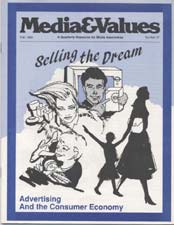Cloning the Consumer Culture
|
This article originally appeared in Issue# 37
|
How International Marketing Sells the Western Lifestyle
No one can travel to Africa, Asia. or Latin America and not be struck by the Western elements of urban life. The trappings of transnational culture - automobiles, advertising, supermarkets, shopping centers, hotels, fast food chains, credit cards, and Hollywood movies — give the feeling of being at home. Behind these tangible symbols is a corresponding set of values and attitudes about time, consumption, work relations, etc. Some believe global culture has resulted from gradual spontaneous processes that depended solely on technological innovations increased international trade, global mass communications, jet travel. Recent studies show that the processes are anything but spontaneous; that they are the result of tremendous investments of time, energy and money by transnational corporations.
This "transnational culture is a direct outcome of the internationalization of production and accumulation promoted through standardized development models and cultural forms.
Creating Consumers
The common theme of transnational culture is consumption. Advertising expresses this ideology of consumption in its most synthetic and visual form.
Advertisers rely on a few repetitive themes: happiness, youth, success, status, luxury, fashion, and beauty. Social contradictions and class differences are masked and workplace conflicts are not shown. Campaigns suggest that solutions to human problems are to be found in individual consumption, presented as an ideal outlet for mass energies... a socially acceptable form of action and participation which can be used to defuse potential political unrest. Consumer democracy" is held out to the poor around the world as a substitute for political democracy. After all, as the advertising executive who transformed the U.S. Pepsi ad campaign Join the Pepsi Generation" for use in Brazil as "Join the Pepsi Revolution" explains, most people have no other means to express their need for social change other than by changing brands and increasing their consumption. Transnational advertising is one of the major reasons both for the spread of transnational culture and the breakdown of traditional cultures. Depicting the racy foreign lifestyles of a blond jetsetter in French or English, it associates Western products with modernity. That which is modern is good; that which is traditional is implicitly bad, impeding the march of progress. Transnational culture strives to eliminate local cultural variations.
Global marketing strategy is so effective that conscious subversion is hardly needed. The message "we will sell you a culture," has resulted in the global advertising campaign, a single advertising message used in all countries where a product is made or distributed. Worldwide advertising is more economical and more efficient, although it may clash wildly with local conditions.
Thus, farmers facing an intensification of violence in rural Guatemala may gather around the only TV set in their village to view an ad for Revlon perfume showing a blond woman strolling down Fifth Avenue in New York.
Transnational corporations and international advertising agencies work hard at creating a consumer culture. Increasingly advertising campaigns are aimed at the vast numbers of poor in Third World countries. Even poor families, when living together and pooling their incomes, can add up to a household income of more than $10,000 per year, making them an important advertising target.
As one advertising professional commented, "Once the TV set goes to work, the family is like a kid in a candy store. They're pounded by 450 commercials a week. They see all the beautiful things. And what they see, they want."
Global Media
Since an important characteristic of transnational culture is the speed and breadth with which it is transmitted, communications and information systems play an important role, permitting a message to be distributed globally through television series, news, magazines, comics and films. The use of television to spread transnational culture is especially effective with illiterates. Grey Advertising International undertook a worldwide study of television to determine its usefulness as an advertising channel and reported that:
"Television is undisputedly the key communications development of our era, shaping the values, attitudes, and lifestyles of generations growing up with it. In countries where it operates as an unfettered commercial medium it has proven for many products the most potent of all consumer marketing weapons as well as a major influence in establishing corporate images."
Anyone who has heard children singing along with television commercials and introducing these themes into their daily games begins to see its impact. Pierre Thizier Seya studied the impact of transnational advertising on cultures in the Ivory Coast. He notes that transnational firms such as Colgate and Nestlé have helped to replace traditional products often cheaper and more effective with industrialized toothpastes and infant formulas. As the report put it:
"By consuming Coca-Cola, Nestlé products, Marlboro, Maggi, Colgate or Revlon, Ivorians are  not only fulfilling unnecessary needs but also progressively relinquishing their authentic world outlook in favor of the transnational way of life."
not only fulfilling unnecessary needs but also progressively relinquishing their authentic world outlook in favor of the transnational way of life."
Advertising of skin-lightening products persuades the African women to be ashamed of their own color and try to be white. Thus, Seya said, Ivorians relinquish their racial identity, one of the most powerful weapons available for safeguarding their human identity.
He also mentions that advertising is helping to change the Ivorian attitude toward aging, making women fear looking older and undermining the traditional respect for elders.
The consumption of soft drinks and hard liquor points to another social change. Traditionally drinks are consumed only in social settings, as evidenced by the large pot where they are stored. Yet, the advertising of Coca-Cola and Heinekens portrays drinking as an individual act rather than a collective one.
A study carried out in Venezuela explores the relationship between television content and children's attitudes. Santoro (1975) analyzed a week of television programming and interviewed 900 sixth grade children. They were asked to invent a story by drawing the characters in a television screen and then describing what they had drawn. The imaginary scenes were primarily stories about violence, crime, physical force and competition, and the large majority of them depicted destructive actions motivated by greed. The "good" characters were primarily from the U.S. white, rich, of varied professions and English surnames. The "bad" characters were mostly from other countries including China and Germany, of black color, poor, workers or office personnel, and with English or Spanish surnames. Santoro concluded that these stereotypes held by children were largely the same ones to be found in typical Venezuelan television and advertising contents.
Fundamental Assumptions
In 1981, Mexico's National Consumers' Institute also found that another group of sixth graders remembered what they learned on television better than the contents of their textbooks.
They knew more about television personalities than about national heroes and recognized more trademarks for snacks, soft drinks, chewing gum and so on than national symbols such as the flag, a map of the country, the major party's symbol, etc. They knew much more about soap operas and action series than they did about episodes of Mexican history.
In yet another study, children from different economic backgrounds were shown pictures of a person in three different settings — family, nature, and luxurious surroundings — and asked to choose which of the three was the happiest. The question was meant to show the degree to which the children accepted the fundamental assumption of advertising: consumption brings happiness. While slightly more than half of the children chose the family scene, poorer children were significantly more likely to associate the luxury possessions with happiness than the rich children.
Perhaps the most interesting result of the study concerns the ability of children to analyze consumption in terms of class. They were shown different categories of consumer products such as cigarettes and television sets, and asked which a rich person could buy and which a poor person could buy. Virtually every child showed an acute awareness of the different access to these products by class. They knew very well that a rich person could buy any or all of the products whereas the poor could buy only the cigarettes, the Coca-Cola, the snack foods, and the lipstick.
These results, while very tentative, suggest that the impact of transnational culture is greater among the poor — the very people who cannot afford to buy the lifestyle it represents. The poor are more likely to associate consumption with happiness and feel that industrialized products are better than the locally made ones. But at the same time they are painfully aware that only the rich have access to the lifestyle portrayed.
This leads us to some important questions. What political impact does the spread of transnational culture have on the poor for whom luxury lifestyles are not possible? And how will they deal with the daily contradictions?



